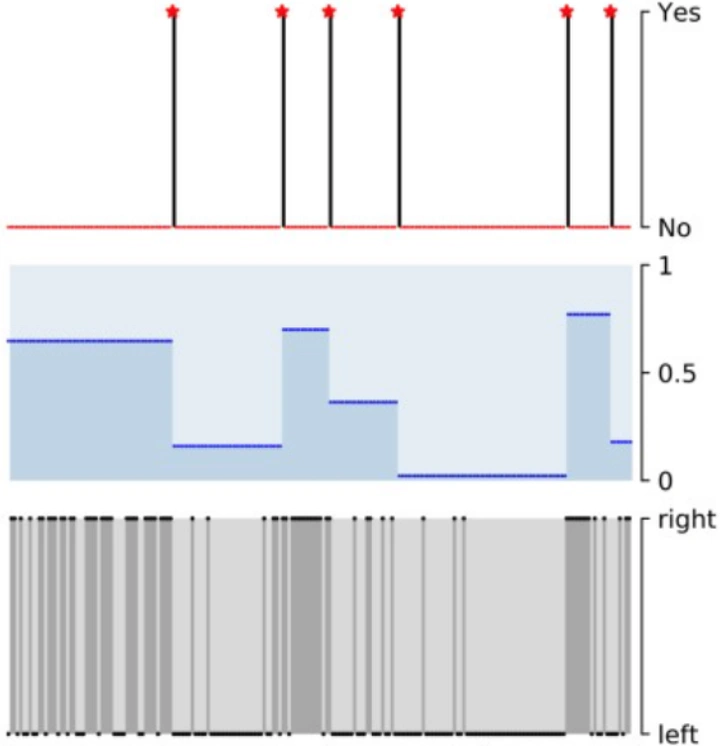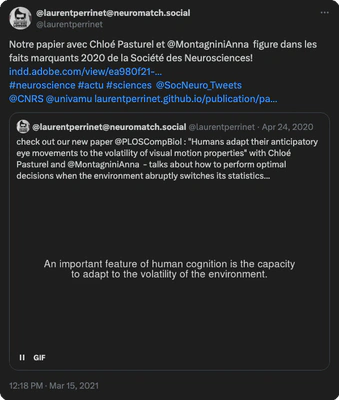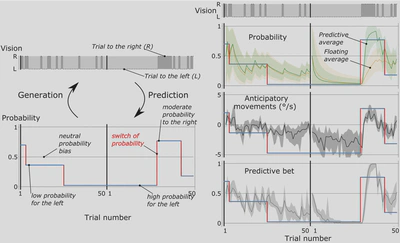Humans adapt their anticipatory eye movements to the volatility of visual motion properties

Abstract
Humans are able to accurately track a moving object with a combination of saccades and smooth eye movements. These movements allow us to align and stabilize the object on the fovea, thus enabling highresolution visual analysis. When predictive information is available about target motion, anticipatory smooth pursuit eye movements (aSPEM) are efficiently generated before target appearance, which reduce the typical sensorimotor delay between target motion onset and foveation. It is generally assumed that the role of anticipatory eye movements is to limit the behavioral impairment due to eyetotarget position and velocity mismatch. By manipulating the probability for target motion direction we were able to bias the direction and mean velocity of aSPEM, as measured during a fixed duration gap before target rampmotion onset. This suggests that probabilistic information may be used to inform the internal representation of motion prediction for the initiation of anticipatory movements. However, such estimate may become particularly challenging in a dynamic context, where the probabilistic contingencies vary in time in an unpredictable way. In addition, whether and how the information processing underlying the buildup of aSPEM is linked to an explicit estimate of probabilities is unknown. We developed a new paired* task paradigm in order to address these two questions. In a first session, participants observe a target moving horizontally with constant speed from the center either to the right or left across trials. The probability of either motion direction changes randomly in time. Participants are asked to estimate "how much they are confident that the target will move to the right or left in the next trial" and to adjust the cursor’s position on the screen accordingly. In a second session the participants eye movements are recorded during the observation of the same sequence of randomdirection trials. In parallel, we are developing new automatic routines for the advanced analysis of oculomotor traces. In order to extract the relevant parameters of the oculomotor responses (latency, gain, initial acceleration, catchup saccades), we developed new tools based on best*fitting procedure of predefined patterns (i.e. the typical smooth pursuit velocity profile).
“Humans adapt their anticipatory eye movements to the volatility of visual motion properties”

At what point should we become alarmed? When faced with changes in the environment, the sensory system provides an effective response.
The current health situation has shown us how abruptly our environment can change from one state to another, tragically illustrating the volatility we can face. To understand this notion of volatility, let’s take the case of a doctor who, among the patients he receives, usually diagnoses one out of ten cases of flu. Suddenly, he gets 5 out of 10 patients who test positive. Is this an unfortunate coincidence or are we now sure that there is a switch to a flu episode? Recent events have shown us how difficult it is to make a rational decision in times of uncertainty, and in particular to decide when to act. However, mathematical solutions exist that adapt our behavior by optimally combining the information explored recently with that exploited in the past. In an article published in PLoS Computational Biology, Pasturel, Montagnini and Perrinet show that our brain responds to changes in the sensory environment in the same way as this mathematical model.These theoretical and experimental results show that in this realistic situation in which the context changes at random moments throughout the experiment, our sensory system adapts to volatility in an adaptive manner over the course of the trials. In particular, the experiments show in two behavioural experiments that humans adapt to volatility at the early sensorimotor level, through their anticipatory eye movements, but also at a higher cognitive level, through explicit evaluations. These results thus suggest that humans (and future artificial systems) can use much richer adaptation strategies than previously assumed. They provide a better understanding of how humans adapt to changing environments in order to make judgements or plan responses based on information that varies over time.
- read the preprint (the official online publication or in PDF is wrongly typeset: the editors inverted the images of figures 2 & 3, while keeping the captions. Unfortunately, the policy of the journal is to issue a correction, but not to correct it. There is therefore no official correct version on the PLoS* website.)
- get a )
- Abstract
- HTML
- supplementary info : https://github.com/laurentperrinet/PasturelMontagniniPerrinet2020/blob/master/Pasturel_etal2020_PLoS-CB_SI.pdf
- Communiqué de presse INSB-CNRS (en français)
- code for paper: https://github.com/laurentperrinet/PasturelMontagniniPerrinet2020
- code for framework: https://github.com/chloepasturel/AnticipatorySPEM
- code for the Bayesian model: https://github.com/laurentperrinet/bayesianchangepoint
- code for figures Figure 1, Figure 2, Figure 3, Figure 4, Figure 5
- video abstract (and the code for generating the video abstract)
- Notre papier avec Chloe Pasturel et @MontagniniAnna figure dans les faits marquants 2020 de la Société des Neurosciences! Voir aussi https://lejournal.cnrs.fr/nos-blogs/aux-frontieres-du-cerveau/les-faits-marquants-2020-de-la-societe-de-neurosciences :

